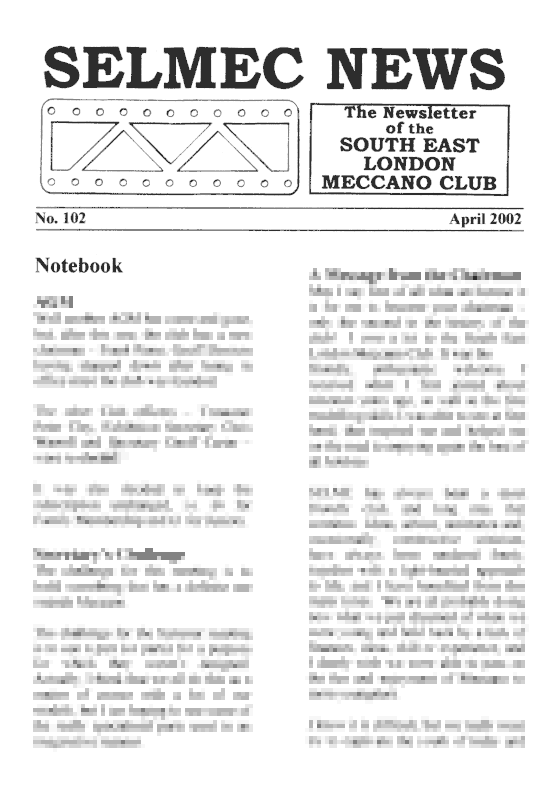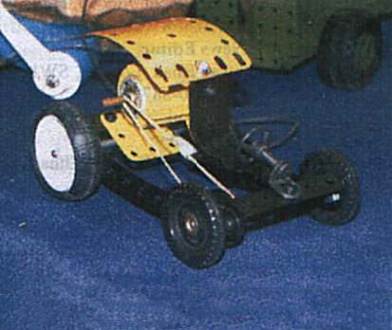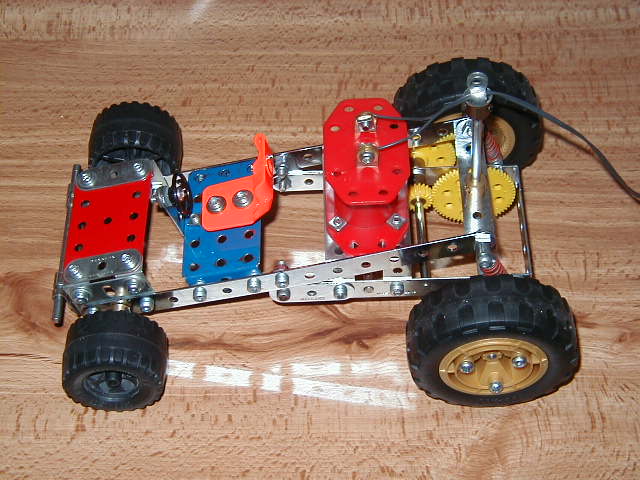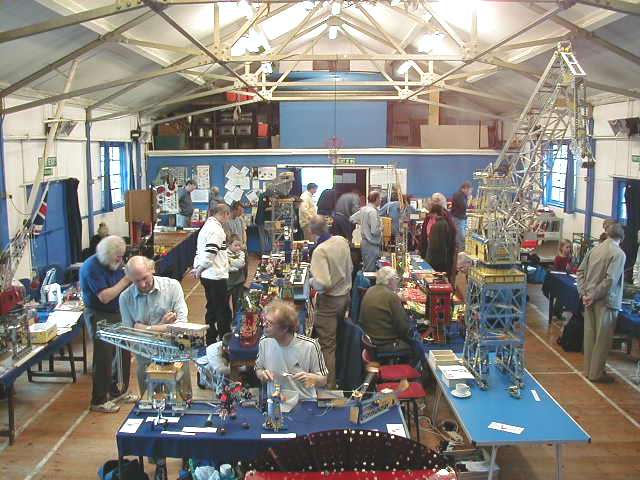April 2002 Newsletter

April 2002 Newsletter
Issue 102
This was one of our informal quarterly meetings where our members showed off their latest Meccano creations.
At around 2:00pm we had a short committee meeting, followed by the Model Tour in which members were invited to give a short talk about their models — in particular their entries for the Secretary’s Challenge!
Written by Brian Elvidge
The idea for this model came from one similar built by Nigel Pope and seen at the SELMEC exhibition at Bromley in 2001.

Nigel Pope’s version

Brian’s version
Construction
The rear sub frame is a pair of 4½” strips and are fixed together by a pair of 2½” x 1” double angle strips placed three and five holes from one end. The front DA bolts also hold a 1½” x 1” corner bracket so one hole is free pointing up. The rear ends of the two strips are connected by a 2½” x ½” DA also holding a pair of spring shock absorbers by pivot bolts (part 147D) so are free to move.
Bolted to the pair of DA’s mentioned above is a French Red 3–6V M0 motor.
An 11 toothed cast pinion is fixed boss outwards on the motor armature shaft. Engaging with this pinion is a 50 tooth contrate gear, plastic preferably, to reduce weight, fixed on a 3” rod located by a collar and a 19 tooth pinion. The last gear meshes with a 57 tooth plastic gear on a 3” rod. The rod is located by a further 19 tooth plastic pinion. The final shaft is a 5½” rod, located by collars, with a further 57 tooth plastic gear engaged with the previous 19 tooth gear.
The rear wheels and tyres come from the recent 50 model set, and are fixed to the ends of the 5½” rod by means of a pair of 6 hole bush wheels, one each side, fixed to the holes in the wheels by 1” bolts and washers inside.
The other sub-frame is a pair of 7½” strips, bolted together by a 2½” x ½” DA across hole 1 at the rear, by a further pair of pivot bolts (part 147D) and the tops of the spring shock absorbers. The lower sub-frame is secured to these strips by the corner brackets single hole and should coincide with hole 8 of the strips. They are connected by 3/8” bolts and a pair of self-locking nuts, adjusted for free movement.
The lower ends of these strips are bolted together by a 2½” x ½” DA and two 1½” flat girders, one each side, forming a bonnet. These can be joined by a 2½” x 1½” flexible plate secured by four ½” x ½” angle brackets, the plate is edged by two 1½” strips.
A drivers seat mounting is a 2½” x 1½” flanged plate bolted between the strips using two washers per 3/8” bolt each side as spacing. On the top of the flanged plate is the drivers seat, using the seat from the 50 model set, bolted to the flanged plate by two ¾” bolts and an orange plastic spacer on each bolt.
The steering wheel, a Meccano Multikit part, is fixed to a 1½” x ½” angle bracket by a ½” bolt and nuts, secured in the central front hole of the flanged plate.
A front bumper bar is two right angle rod connectors with a 3½” rod fixed in the front holes of the 2½” x ½” DA of the sub-frame.
Lastly the front wheels — a 4” rod retained by collars, bearing each end wheels of choice, 1” pulleys and tyres or French road wheels or Liverpool 3 part road wheels. A device to prevent the motor wheels fouling the rear wheels is a rod socket secured to the rear DA with a 2½” road and an end bearing.
It is important to use a rubber band for the drive and not a Meccano drive band.
Report written by Chris Warrell
20th October 2001 saw our annual Meccano Model Exhibition take place at the 3rd Bromley Scout Hall; a venue that we have used for the past few years. It’s a good sized hall and we managed to easily fill all the available table space, with a little bit of juggling around. Hopefully no one felt they were too squashed.
There was quite a variety of different models — there were no less than three large cranes towering over the smaller models, which made the overall display look appealing.

A view of the hall, with Ted Muggridge’s level-luffing crane on the right
The 140 or so members of the public who turned up appeared to enjoy themselves, many staying for quite some time. I also had received a number of enquiries weeks beforehand. The week after the exhibition, there was a very colourful spread in the Bromley and Hayes edition of the News Shopper. Three photographs and a short description appeared on the Picture Special page under the headline ‘100 Years of Modelling’.
Watch our video of the exhibition
Thanks, of course, must go to everyone who brought models, helped on the door, put up posters and banners, and to the few who turned up on the Friday night to set out the tables.
Models on Display
Peter Clay brought a number of small models: A helicopter, with rotating main and tail rotors and light; An obstacle-climbing vehicle; The Spirit of St. Louis aeroplane; Caterpillar tractor; Motorbike; Station platform tractor and trailers; Stock car; Twin steering vehicle.
A 1:40 scale model of a 150 ton hammerhead crane was shown by regular guest Eddie Oatley. It was based on the real one seen at Barrow-in-Furness. The model was fully operational and contains six electric motors and 3,000 nuts and bolts.
Nigel Pope, back to modelling this year, had an impressive display which included Tower Bridge; Mersey ferry; floating boat; Flying helicopter; Spotter plane; Rock band; Two Meccanographs; Supermarine S4 float plane; BT Tower; Games spinner; Five army vehicles; Three clocks; Helicopter; Four motorbikes; Chinese compass; Christmas toy; Walking ‘Meccanosaur’; Electric car; Steam engine; Birthday card.
New member Brian Elvidge brought his table top block-setting crane. This won the Philip Bradley Trophy at the Holy Trinity Meccano Club’s April 2001 meeting. The model reproduced all the normal movements of the original, using E15R and E20R motors. He also had a 1962 № 5 set roundabout, a windmill from that year’s № 3 set, and a special edition crane from the 1999 set.
John Cowdery’s arrangement consisted of a № 9 set Liverpool ferry (complete with Tony Parmee’s ‘rock and roll’ mechanism); A 1950s № 9 set windmill; A battery-powered French Gendarme; A № 8 set coal loader in a wooden carrying case.
All the way from Manchester, on the train, visitor Dick Watson (North West Meccano Guild) brought a tower crane with a level-luffing, articulated jib.
Exhibition organiser Chris Warrell had a modified version of the Super Model 19A steam excavator, using the 1970s steam engine, and the locomotive coaling plant from the 1950s № 9 set.
David Smithers brought an improved version of the 1970s № 5 set model of Watt’s beam engine, and Robert Fulton’s experimental paddle steamer engine.
Len Spink was showing two car chassis, a tipper lorry from 1930s set № 8, in contemporary blue and gold, as well as some smaller models.
In Jim Arthur’s collection was a Ferris wheel, a Ferrari car, flak gun, 105mm gun, V-twin engine and some mini models on a base.
Tim Surtell brought his chocolate vending machine, a model teacher and a weightlifter.
Paul Heather had a twin-cylinder steam engine and a large model of a ‘Revenge’ class battleship.
An assortment of models was brought by Les Maher, including a remote-control dockyard crane with grab, in red and zinc, using five motors; A tricycle (with a small homemade pawl); A set of scales; Caterpillar track.
New member Ted Muggridge was showing an incomplete ½”:1’ scale model of a level-luffing Crane. It had 10 motors, but will require more weight to make it work. The model uses a number of ½” x 1½” x ½” channel girders in its construction.
A collection of models from Andrew Couzens: A horse and cart and a sports car, both in red and green; A mobile crane with dummy caterpillar tracks in yellow and zinc; An incomplete 0–6–0 steam locomotive and the body of a railway carriage.
Geoff Carter displayed 15 small set models including an infra-red control ‘dozer-type’ model.
A 1920s crane and four ‘Magic’ motor models were amongst the items brought by Jim Ellicott. He also showed a Chinese construction set, a Lynx construction set and a set of Meccano for ‘hands-on’ modelling.
George Foard brought Konkoly’s Cyclic Colour Mixer, a dealer’s display model big wheel and a display of tricycles and motorcycles.